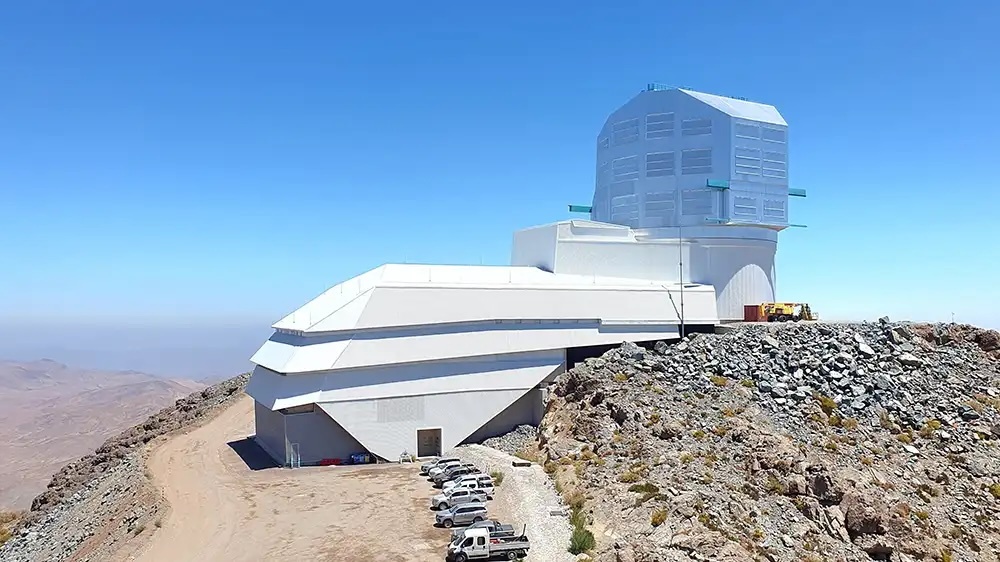30.04.2025

The building of the Vera C. Rubin Observatory on Cerro Pachón in northern Chile. The telescope sits in the cylindrical dome on the upper right; the control room, offices, and the coating plant are located in the multi-story left part of the building.
Govert Schilling
“It’s easy to get lost,” says Leonor Opazo as she takes me through a number of hallways and into various elevators to reach the top level of an eye-catching building. I am visiting the Vera C. Rubin Observatory, and I’m happy to have Opazo as my guide. The administrative manager of the Cerro Tololo Inter-American Observatory, which is also operated by the U.S. National Science Foundation National Optical-Infrared Astronomy Research Laboratory (NOIRLab), is a frequent and very welcome guest at nearby Cerro Pachón, where Vera Rubin, as the facility is affectionately known, is nearing completion.
However, despite Opazo’s mediation, I’m apparently in for a setback. My visit had to be planned well in advance, and back then, no one knew exactly what kind of construction activities would be going on. When we reach the telescope level of the observatory, workmen don’t allow us to walk around to get a good view of the impressive new instrument. I have trouble concealing my disappointment.
Since the early 21st century, Cerro Pachón, a 2,700-meter (8,900-foot) mountain in Chile, has been home to NOIRLab’s 8.1-meter Gemini South Telescope and the 4.1-meter Southern Astrophysical Research (SOAR) Telescope. But over the past decade, a third facility has been erected here, named after dark matter pioneer Vera C. Rubin. Later this year, the huge 8.4-meter instrument will start a massive 10-year survey of the sky, hunting for transient phenomena and producing a 3D map of the universe (see the June 2024 issue of Sky & Telescope). “We’ve experienced a number of delays, partly due to the Covid pandemic,” says Opazo, “but I’m absolutely certain that first light will be achieved this year.”
The unusual but elegant design of the 10-story observatory building minimizes air turbulence that might affect the observations. I don’t see an official entrance or reception; instead, Opazo takes me through a metal door, next to a small plaque commemorating the primera piedra — the laying of the first stone in April 2015. Before long, we’re entering a huge area that looks like a factory hall.
Actually, it is a factory hall: This is the coating plant, where Vera Rubin’s giant primary mirror will receive a new layer of reflecting silver every two years or so. (To do so, the mirror will first have to be lifted out of the telescope and lowered to the building’s ground level in a 10-meter-wide elevator.) The same coating facility is used for the instrument’s secondary mirror, which has a diameter of 3.4 meters — the largest convex mirror ever made.
During my visit, the large coating chamber sits idle, but elsewhere in the hall, the telescope’s 3.2-billion-pixel camera is being prepared for its final installation just four weeks later, on March 12th. Funded by the Department of Energy and built at the SLAC National Accelerator Laboratory, it is the biggest digital camera ever built, as large as a small car and weighing more than three tons. Seen from a meters-high walkway, the black camera and its teal-colored support structure remind me of NASA’s historic Gemini spacecraft; the technicians with their hard hats resemble space-walking astronauts. In a sense, the camera will indeed embark on a cosmic voyage, going much further than any spacecraft has ever flown, by taking an extremely deep 9.6-square-degree image of the sky every 30 seconds.
At two separate intermediate levels, I can actually enter the hollow telescope pier — a 16-meter-diameter concrete structure with 1.25-meter-thick walls that supports Rubin’s 350 tons. However, looking at the intricate power, coolant, and electronics cables beneath the instrument is no substitute for a close-up view of the giant telescope itself. Stupid construction schedule, I think to myself, as we head out of the building to visit neighboring Gemini South and SOAR.
But later that afternoon, Opazo has good news. She’s been in touch with French-born optical engineer Jacques Sebag, who has been with the project since the very beginning and who came up with Rubin’s unusual design. “We’re allowed to go in after all,” she says, “and Jacques will give us a quick tour.” I’m as happy as a child on Christmas morning.
Sebag takes us through the hallways and up the elevators all over again, rapidly answering my numerous questions about “his” telescope in a heavy French accent. The instrument has a revolutionary and very compact optical design, with a 5-meter-wide tertiary mirror embedded in the 8.4-meter primary: cast and grinded by the University of Arizona’s Mirror Lab in Tucson, the mirror’s central area has a much stronger concave curvature than its 1.7-meter-wide outer rim. “My original design was more conventional,” Sebag explains, “but because the telescope needs to slew very rapidly from one sky position to the next, it had to be extremely compact and stiff, so I came up with this solution.”
Eventually, we arrive at the observing floor again, and now I’m allowed to walk around the impressive instrument, which is still partly surrounded by scaffolding. It is so huge that it almost completely fills its 30-meter-diameter dome (actually more of a cylinder); even with a wide-angle lens it’s hard to take decent pictures. Since Rubin is in its horizontal resting position, I can actually look through its top end to see the curved reflections of the telescope in the combined primary/tertiary mirror. Just a few months from now, I think, this piece of silver-coated high-tech optics will start observing the distant universe.
n fact, it has already done so. In October 2024, astronomers and technicians obtained a first-light image with a commissioning (or test) camera, and although the result has not been released to the public, Sebag assures me that it looks gorgeous. “It was extremely satisfying to see that the unusual telescope design works so well,” he says.
That night, before going to sleep in one of the dormitories at nearby Cerro Tololo, I step outside to marvel at the ink-black sky, adorned by thousands of glittering stars and the majestic band of the Milky Way. I can only imagine what spectacular images and unexpected discoveries the Vera C. Rubin Observatory will soon start to deliver.
Quelle: Sky&Telescope
